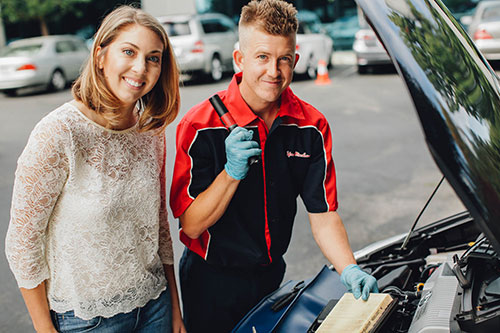YourMechanic and Airbase: Simplifying purchasing.
How YourMechanic uses Airbase to simplify purchasing at scale and make spending and financial accountability a part of the conversation.

Diana Ngo
Senior Director of Finance at YourMechanic
Takeaways:
- 5% savings/month on subscription-based spend.
- Over one week’s worth of time back for the Finance team per month.
- Increased company-wide accountability for spending.
YourMechanic, based in Mountain View, California, helps car owners schedule service appointments with expert mechanics that will come directly to the customer’s home or office to perform the service.
While customers only see an easy-to-use app and the on-site mechanic, YourMechanic has a complex logistics network running behind the scenes to make sure that mechanics have all of the parts they need to complete their jobs.
The challenge of optimizing purchasing falls to Diana Ngo, the Senior Director of Finance at YourMechanic, and her team. “We’re very transaction heavy,” she explains, “we do about 15,000 transactions per month. That’s a lot of parts that we have to purchase.”
The problem: Risk-heavy, time-intensive purchasing.
YourMechanic’s Purchasing team managed buying and paying for parts with two tools: a Wells Fargo corporate credit card, and a shared Google sheet.
Whenever customers scheduled a new service, the purchasing team determined the parts necessary to complete the job, found a dealership with the items in stock, and ordered them using the company Wells Fargo card. The dealership sent the PO post-purchase. The parts team then recorded the PO number and the transaction details in a shared Google sheet for the Finance team.
The sheer scale of operation — over 500 transactions a day — magnified the inefficiencies in each step of the purchasing process.
Using a single Wells Fargo card was a huge risk because it was susceptible to fraud. “We were using a single, physical card to buy from dealerships in over 30 states,” Diana told us, “Now and then, someone [at these dealerships] would get the idea to take the card and go shopping.”
The consequences were dire. “We relied on Wells Fargo to give us a call in case of a fraudulent charge but over a thousand dollars of damage could be done by the time we were notified,” Diana says.
Cancelling the card also meant that the team needed to get new payment information to its entire vendor network. “It got to a point where we actually got a new card every two months. We also had a second card as backup, because we couldn’t jeopardize dealer payments in case the one we were using was flagged for fraud and blocked.”
Tracking transactions in the Google sheet was a pain point too because of high error rates. “We had to deal with wrong dates, dealer names not matching the name on the card statement. The error rate was over 50%. There were some credit card charges that we couldn’t even tie back to a PO.”
Finally, there was the time-intensive close.
“When there’s a reconciliation of three different systems, it’s never 100% accurate. Even if we’d done all the right prep, coding charges into the GL took our staff accountant a whole day.”
“Since the close was such an exercise,” Diana adds, “we did it once a month and we went into it blind, not knowing what to expect.”
Evaluating solutions.
With her years of experience in Finance, Concur was the first piece of software Diana evaluated to solve the problem. “Concur has been a staple,” she says, “for years and years. It’s been the application that you would use for all types of credit card charges and expense reporting.”
But Concur proved a difficult fit for YourMechanic’s workflow. It didn’t lend itself to the Purchasing team’s process of making a payment without a PO and attaching it to the transaction afterwards.
It also didn’t address the risk of using a single credit card in so many places.
Between the inflexibility and the risk, Diana decided that Concur wasn’t the right choice for YourMechanic. This was when she discovered Airbase and realized it was exactly what her team needed.
Diana told us exactly what tipped the scales: “Airbase was so intuitive and easy to maneuver. Functions weren’t lost in there. With Concur, you have to go looking for solutions, they don’t pop out in the interface. But Airbase is pretty simple, considering the depth of what it does. It just makes sense. Concur is a hard, inflexible platform. And it didn’t have the virtual card functionality we loved in Airbase.”
Implementation.
Onboarding was a straightforward process that happened in two stages.
Diana’s top priority was the Purchasing team, so she rolled it out to them first. Airbase replaced the two tools they were using — the single-point-of-failure Wells Fargo card and the Google transaction sheet.

YourMechanic provides expert services across the US
Training was simple. Diana showed the Purchasing team the interface, demonstrated the new transaction workflow, and they were making expense requests and generating virtual payment cards within minutes.
Rolling it out to the whole company was even easier than rolling it out to the Purchasing team.
“It’s so easy and intuitive,” Diana says, “we didn’t even have to train the rest of our employees on how to use it.”
“Today, Airbase is available to everyone. Any manager or employee who needs to spend on subscriptions or anything at all can easily log into Airbase and manage the expense themselves.”
Simplifying purchasing with Airbase.
“Today, we have the Purchasing team go into Airbase and create a single-use virtual card every time they have to buy from a dealer,” Diana says.
Virtual cards give the finance team all the controls they need to make sure that security doesn’t slow payments down. Each virtual card comes with spend limits that the finance team can set and edit directly within the Airbase platform.
Fraud isn’t a problem anymore because incidents are isolated to the unique virtual card created for that vendor.
An unexpected benefit of using virtual cards — dealer relations. “Not only is it easier for the Purchasing team to pay vendors,” she tells us, “it’s easier for the dealer that they’re working with as well. Virtual cards make communication with the dealer quicker and easier.”
“As far as the close is concerned, it now takes no time at all. Because Airbase codes transactions over the course of the month, we’ve managed to save about a day’s worth of time during the close.”
“Our staff accountant is now doing more FP&A work,” we were delighted to hear Diana tell us. “He’s working more closely with the VP of Finance instead of spending all his time on manual AP tasks that he was way too smart for.”
Beyond purchasing: Making finance a part of the conversation.
With the whole company using Airbase, the platform has become an internal “hub” for the organization, explains Diana.
“It’s one place everyone in the company can go to where data on money and spending is visible and accessible. I overhear conversations about spend all the time now. Airbase makes it easy for people to hold themselves accountable for their spending.”
“It’s not just that people are more responsible with money,” she adds, unpacking the impact, “it’s that they’re more independent.”
“The teams love Airbase because they can log in and look at a report of what they’ve spent over time. And managers have more insight into what’s being spent in their departments. They don’t have to come to us and say ‘hey, can you run this spend report for me’ anymore — they can do it themselves.”
The increased visibility has been particularly useful in spotting duplicate subscriptions. “Airbase makes it easy to see if someone else has the same app. So now it’s easy for the finance team and managers across the company to ask, ‘why don’t we just use the tools we already have?’”
“The visibility really helps us make better decisions as a company. We’ve saved a good 5% in recurring spend with the visibility and control that Airbase has given us.”
The most impact that Airbase has had, however, would have to be on the Finance team.
Diana estimates that Airbase has given the Finance team about a week’s worth of time back each month.
“Airbase makes it very easy to see run rates and make projections based on past company spending trends. It’s replaced downloading data [from the GL] and making pivot tables, eliminating hours per month in FP&A.”
The extra time back has been invaluable. “Since we’re a startup, we’re pretty lean,” she says, “And having Airbase is like having extra accounting staff. I’ve been doing accounting for a long time and I’m amazed at how much my small team can get done with Airbase.”
“It’s very hard to imagine doing business without Airbase now. It’s the new best business practice.”
 Jira
Jira  Ironclad
Ironclad  Asana
Asana 


